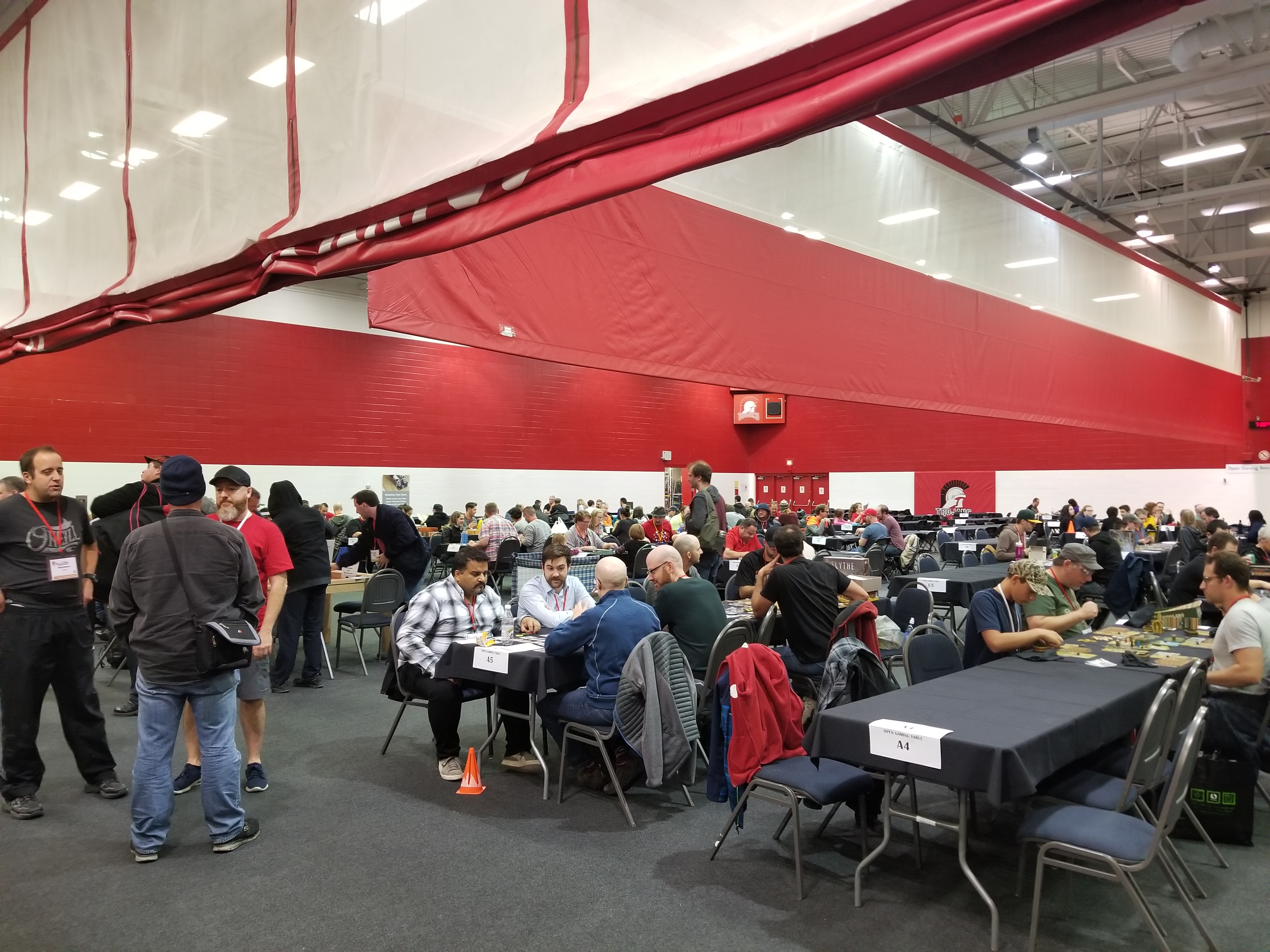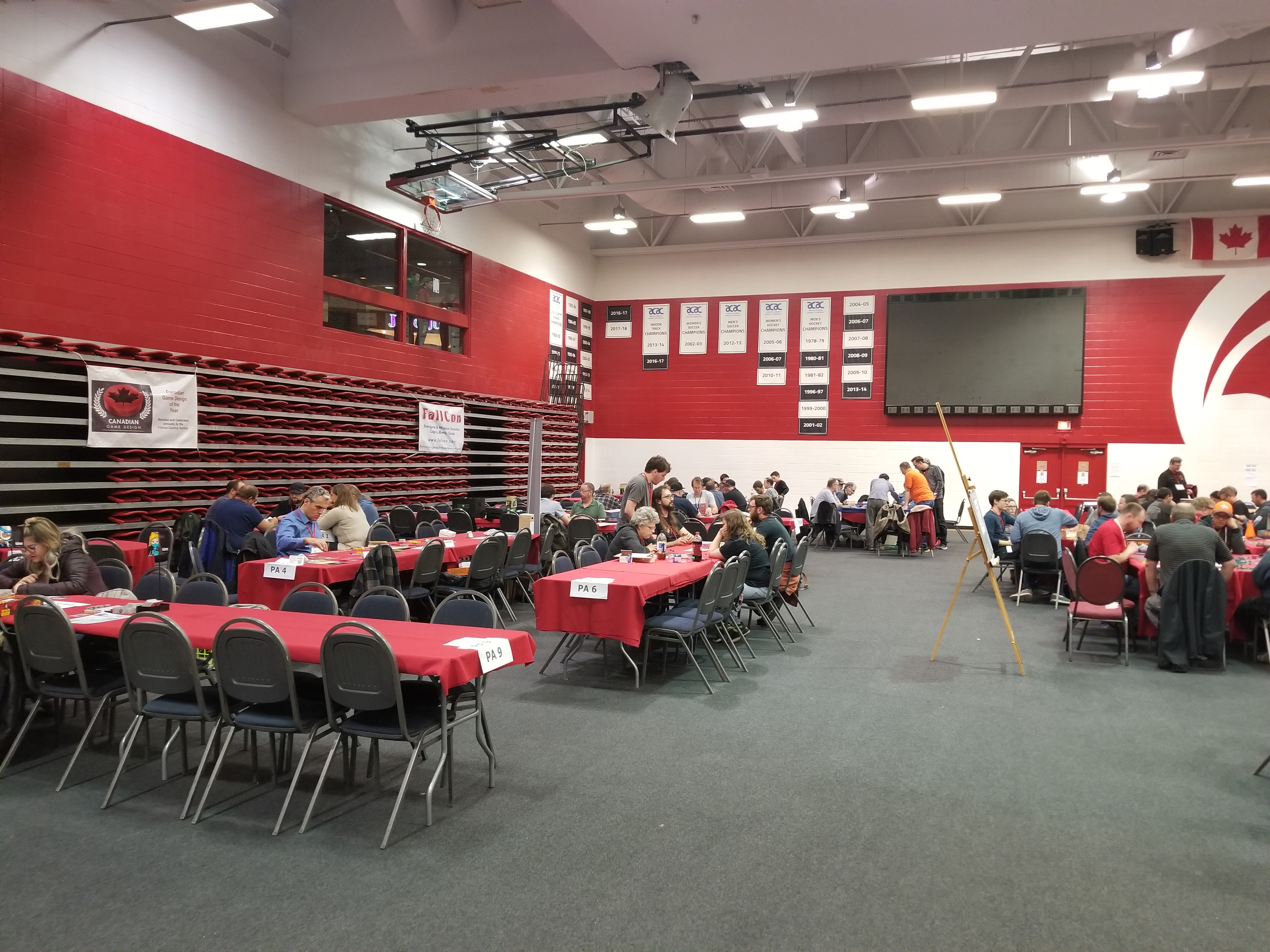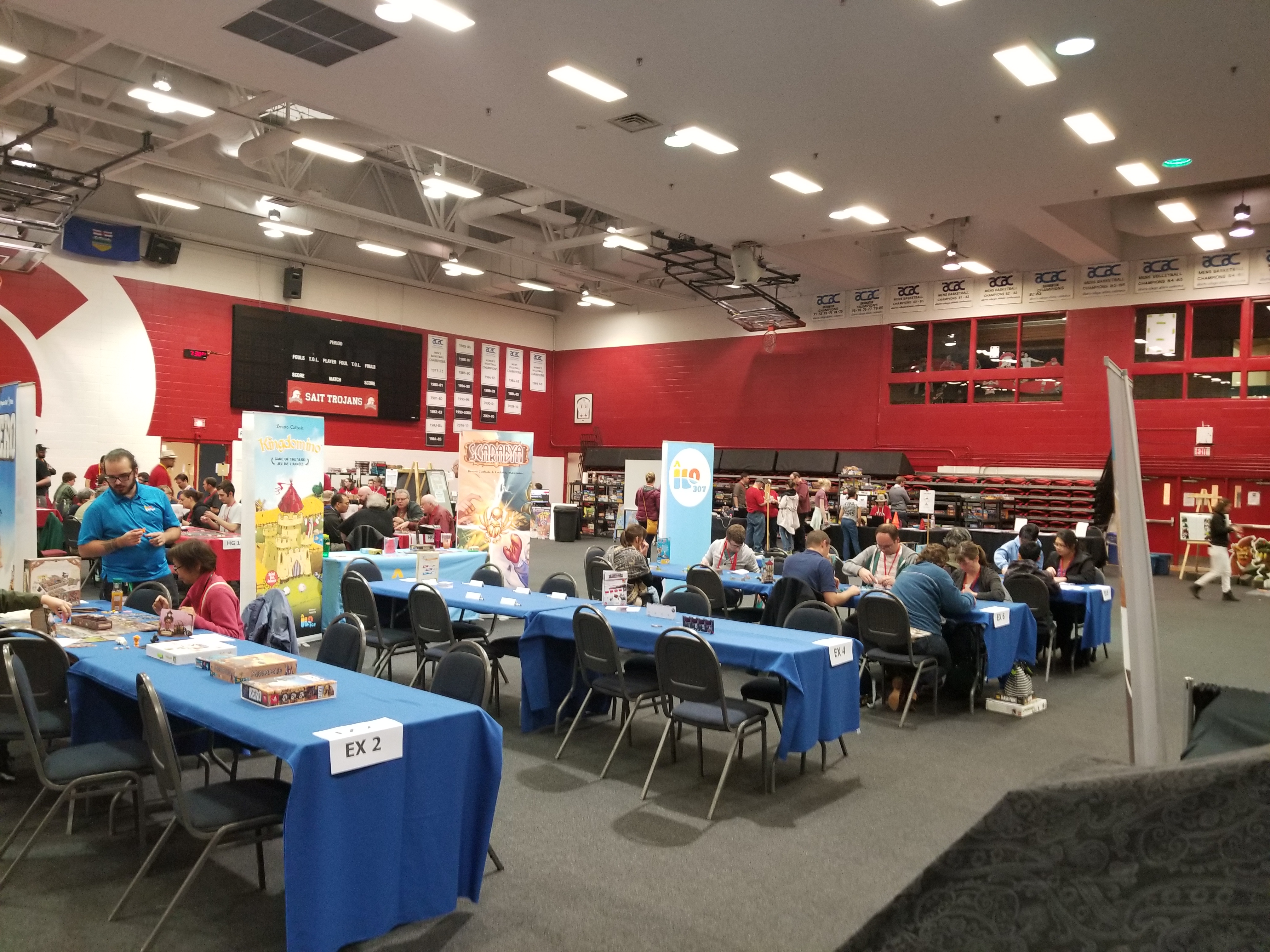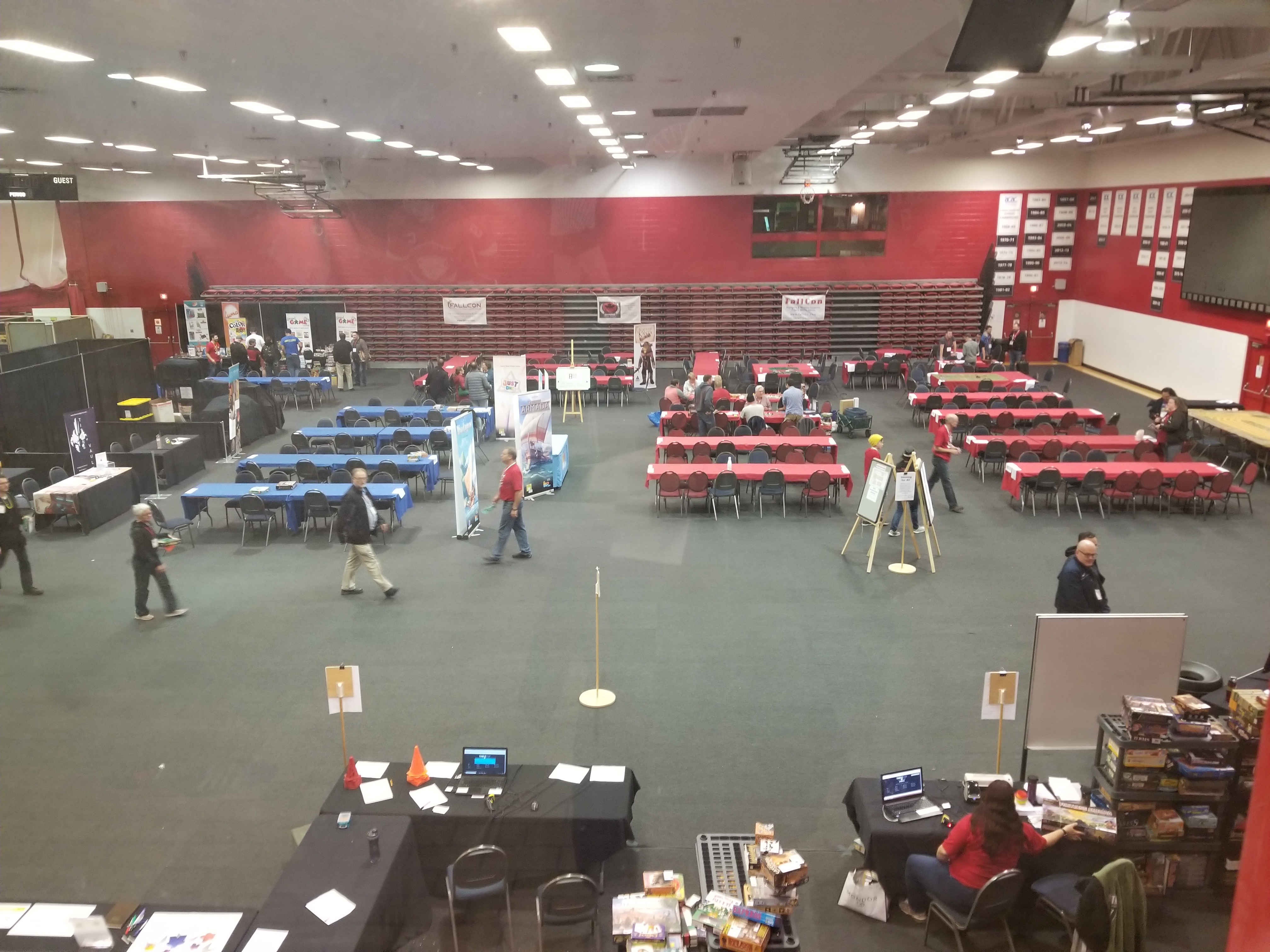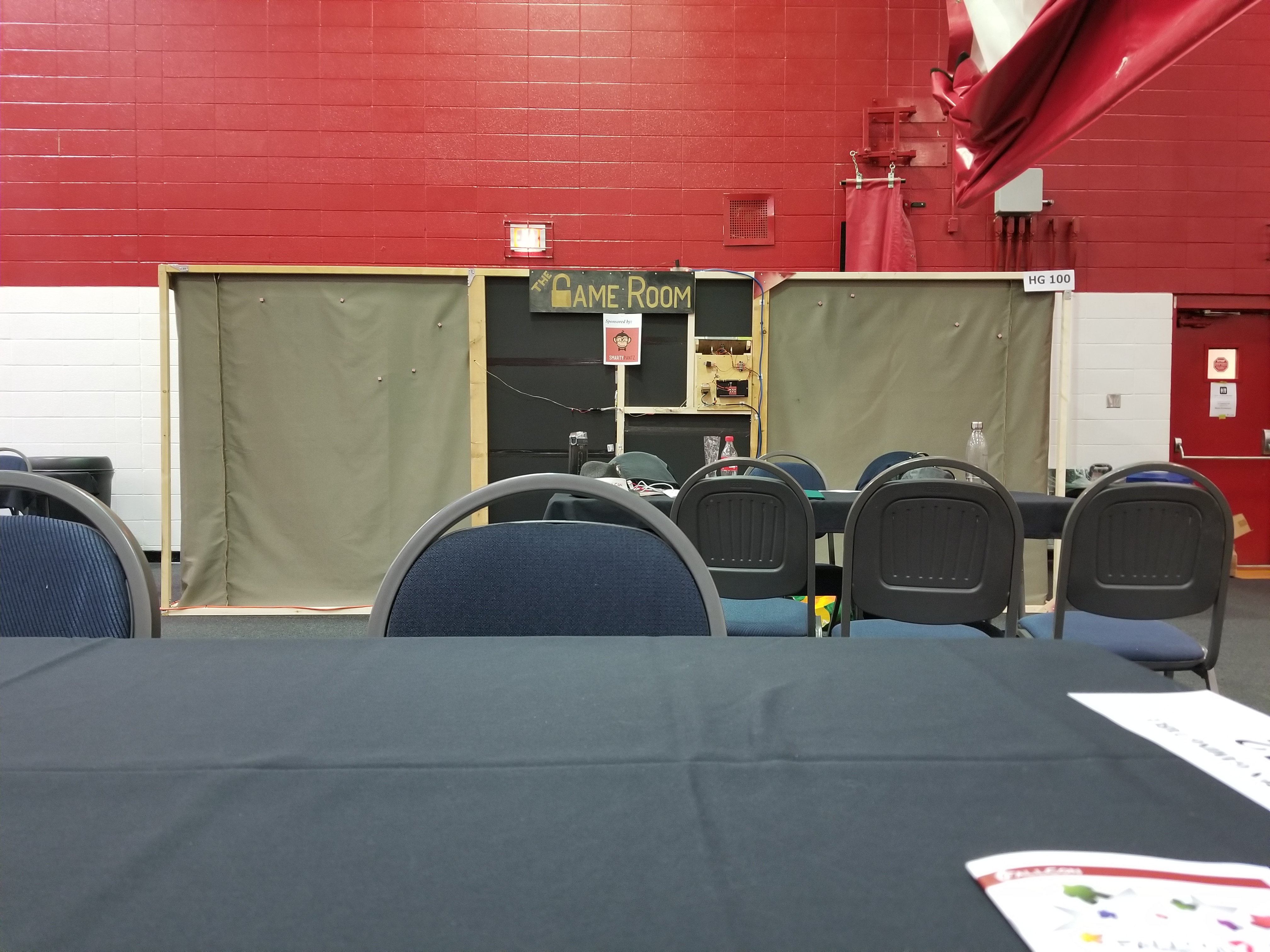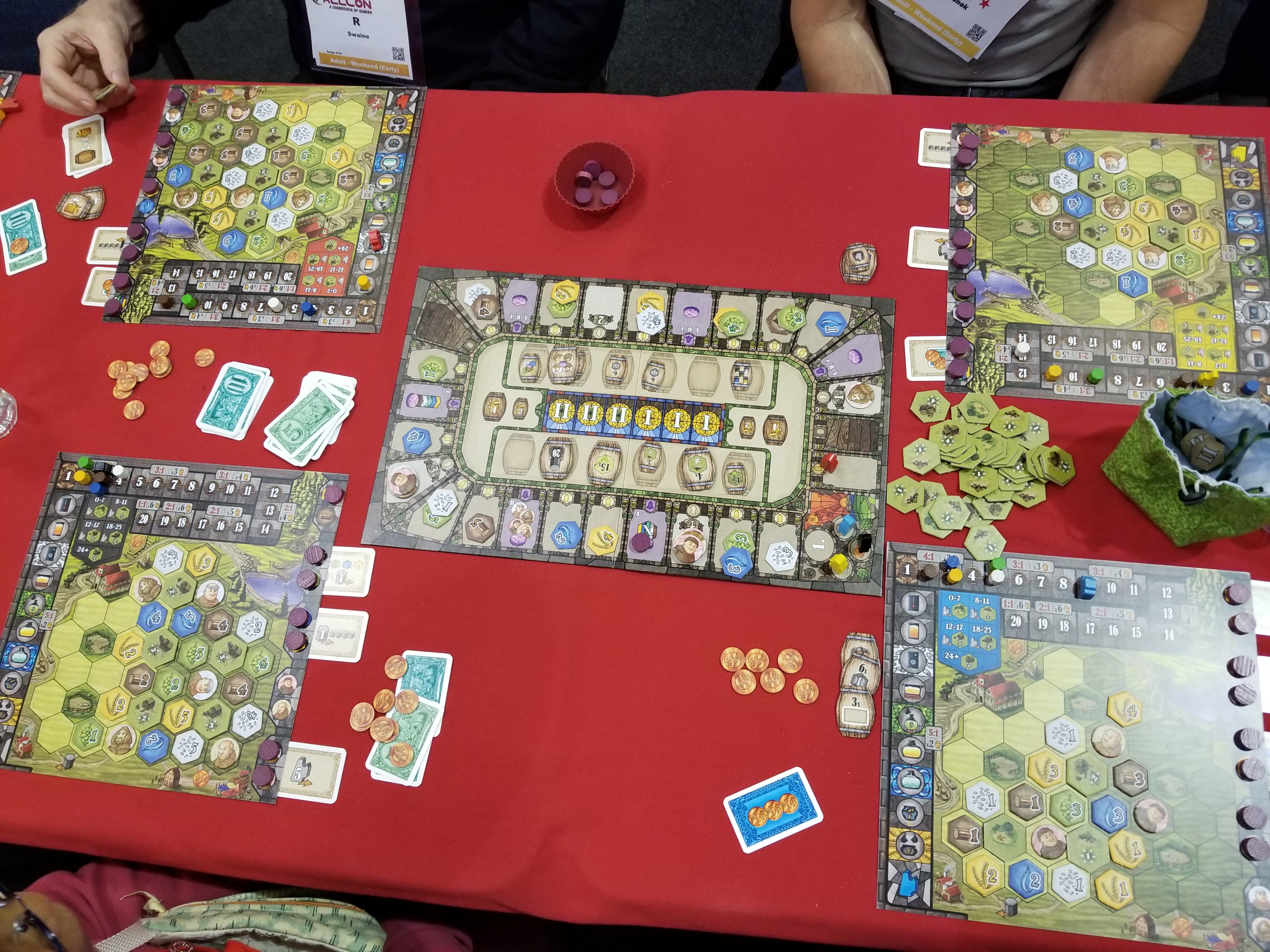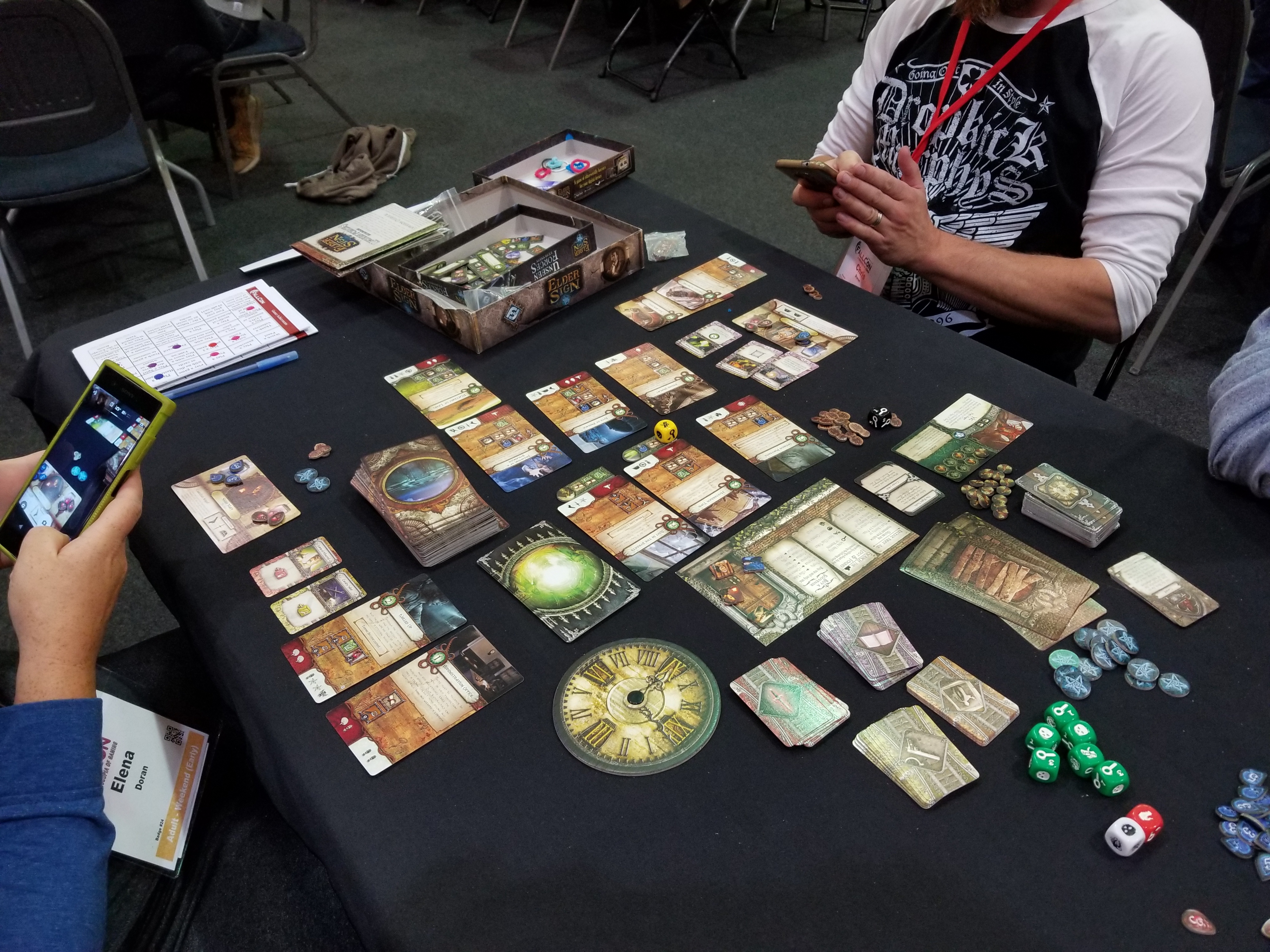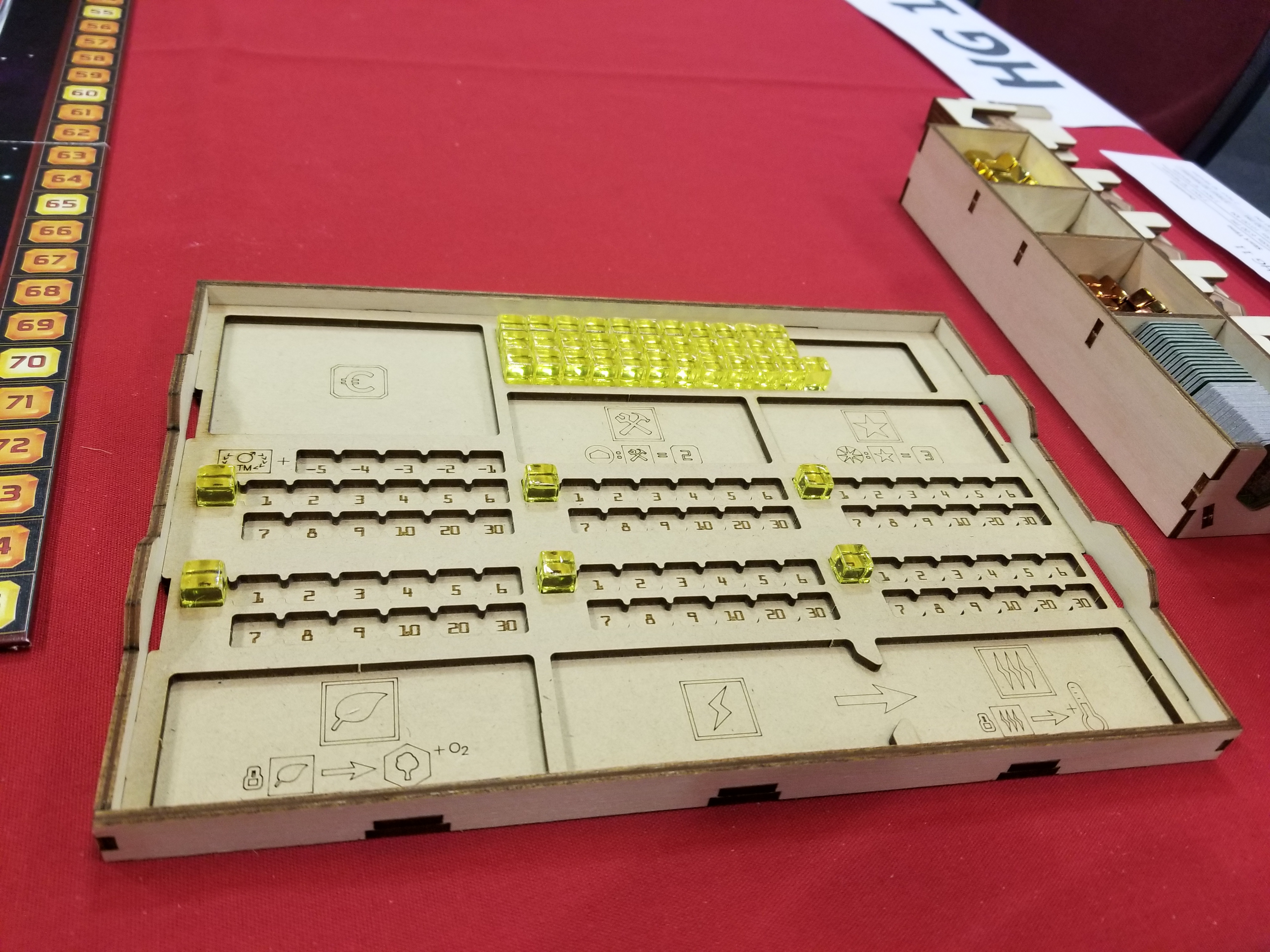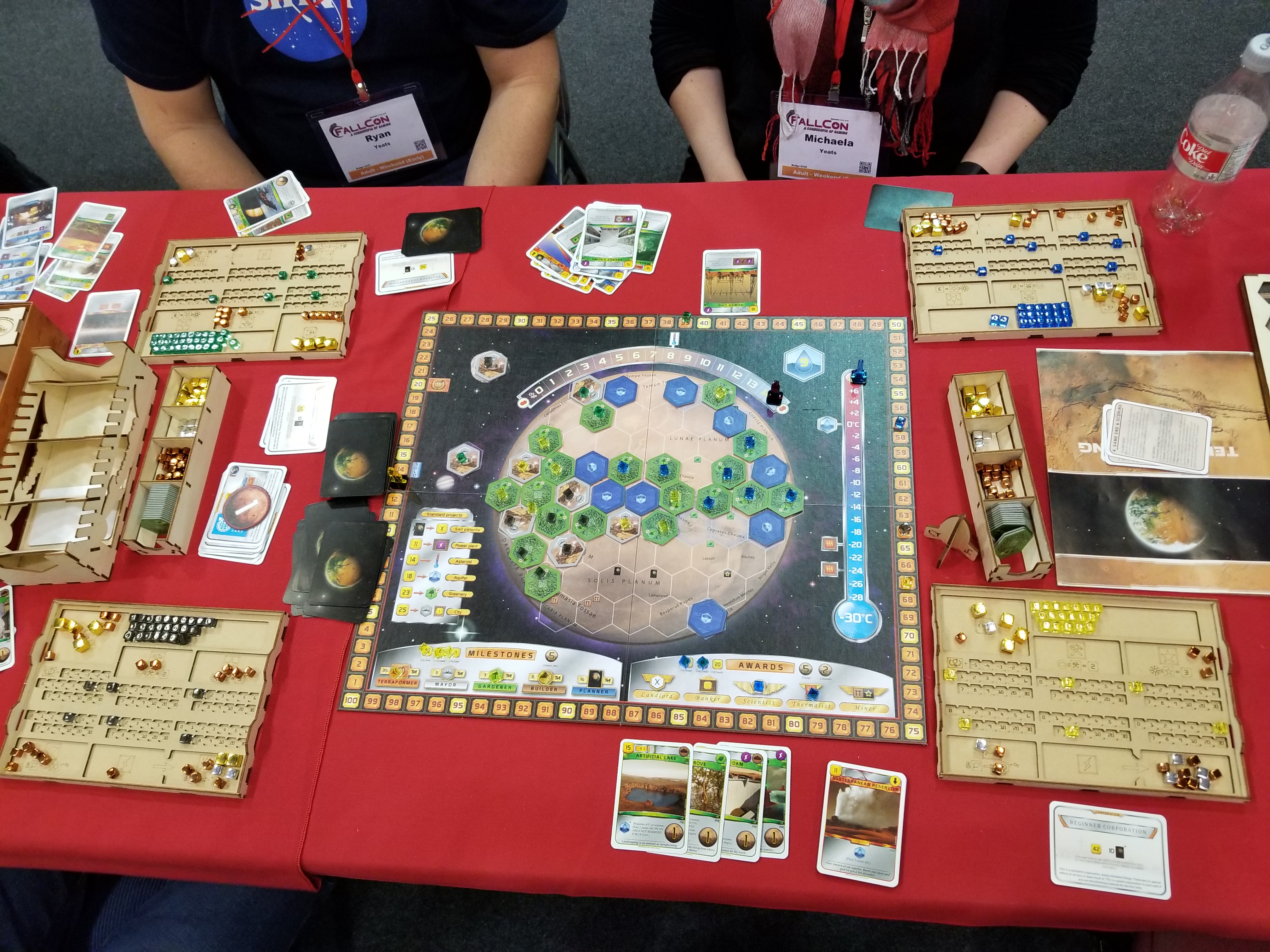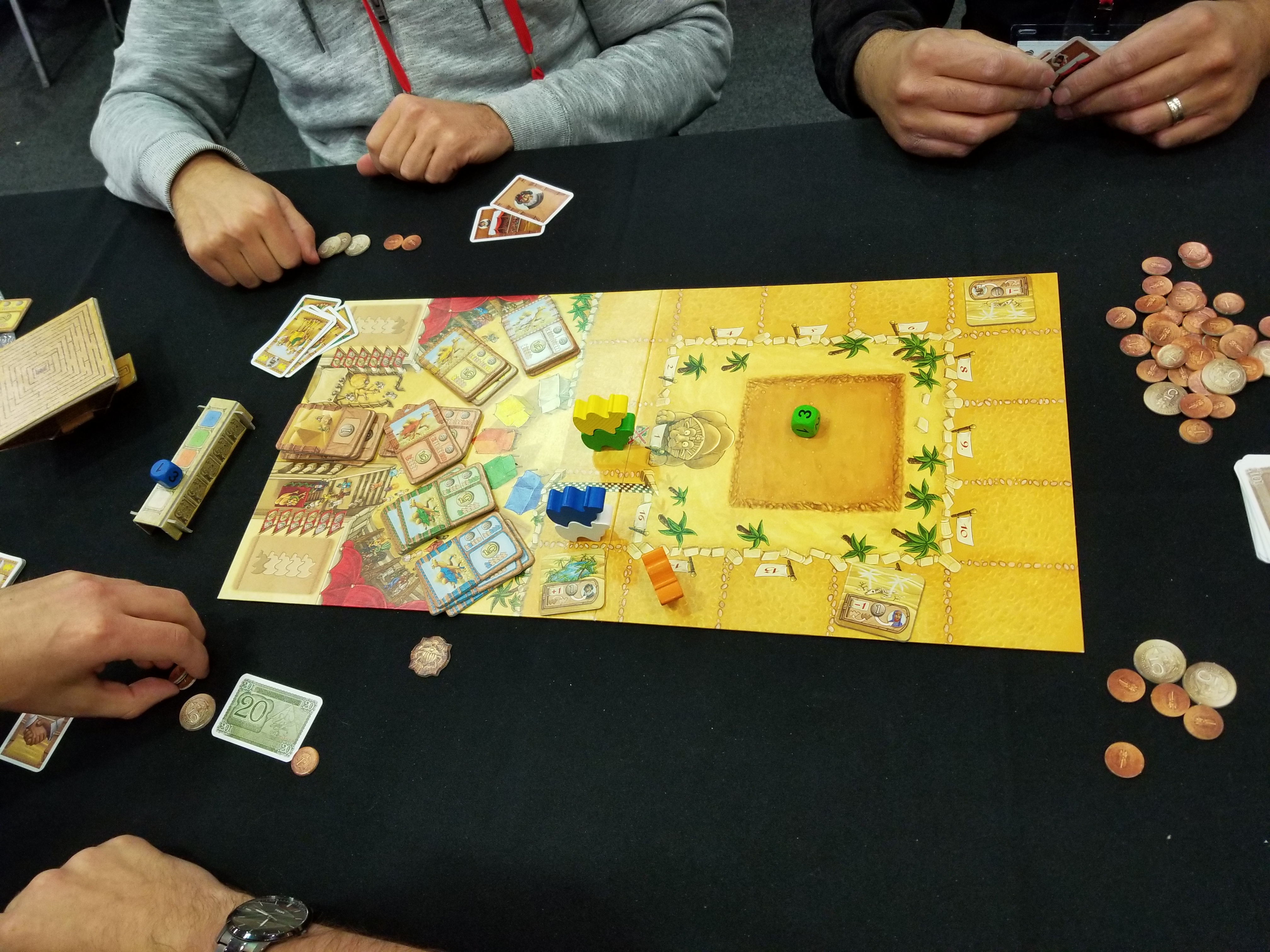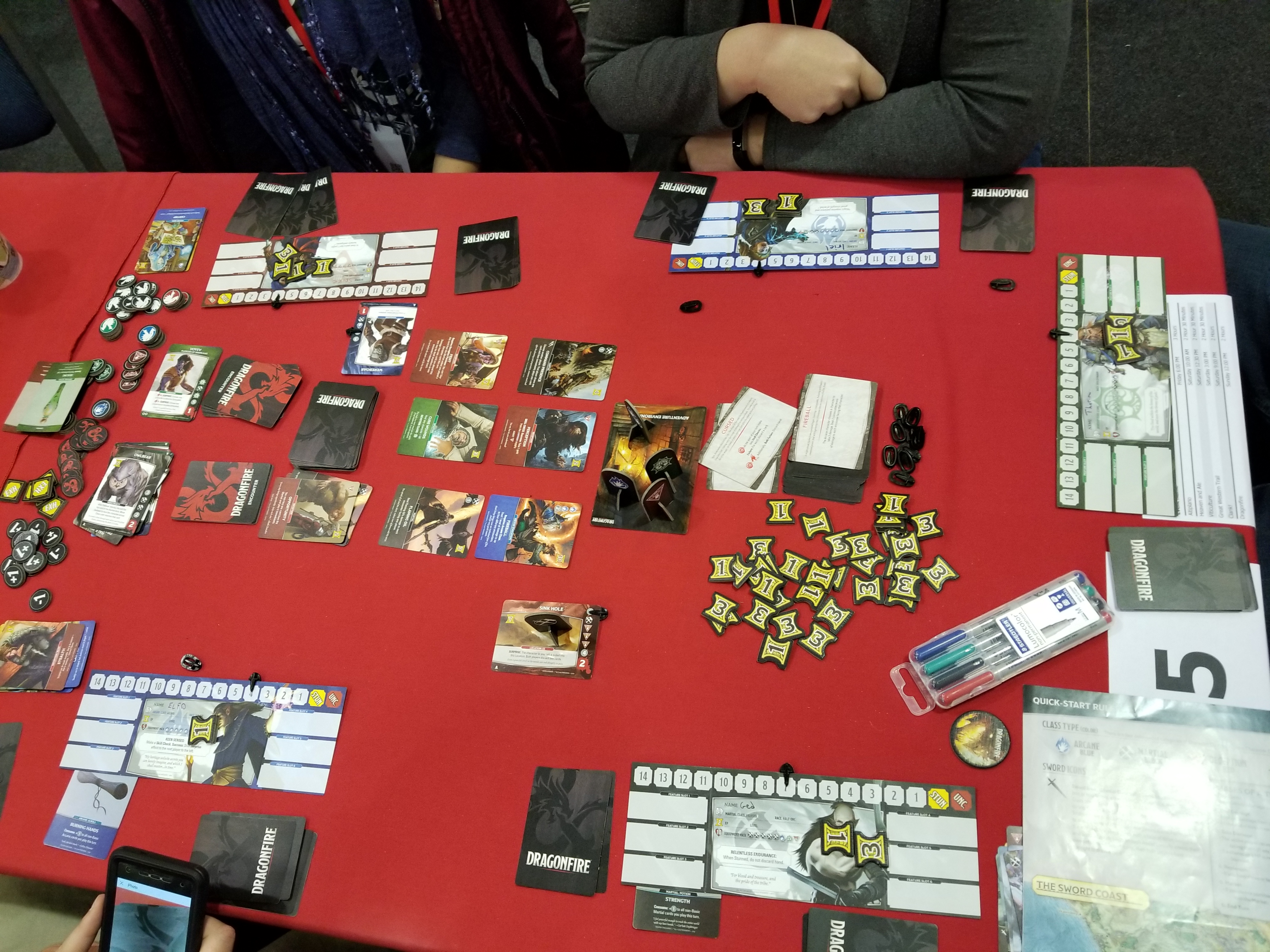FallCon is an annual boardgaming convention that takes place in Calgary, Alberta, over three days (Friday night, all day Saturday, and Sunday morning/afternoon; 28 hours total). This year was FallCon 31. I haven’t been able to attend FallCon for a while, but I’m so happy to be back and don’t plan on missing another year, if I can help it. Being the “game guy” in the family, I almost never have opportunities to play games I didn’t purchase myself. So FallCon is a rare opportunity to experience new games first hand.
A huge thank you to the FallCon committee and volunteers for making the convention possible!
FallCon offers a number of different experiences:
-
The most popular is the open gaming area. Now that they’re in the SAIT gymnasium, the open gaming area is enormous. You also have access to their massive game library. You can just check out a game and go find a table. They also have a system for signalling that you’re looking for more players or looking for someone to teach you the game.
-
They also have “hosted games” where a dedicated host teaches a group of people how to play a game, which you then sit down and play. This is my favourite part. It’s an ideal way to learn a new game, and it’s one of the few times I get to try a game before maybe buying it. There are multiple hosted sessions a day, and multiple different games being offered in each session, so you can almost fill up your entire schedule with hosted sessions. You also get to meet lots of different people.
-
Prototype corner is a space where game designers bring their unfinished and close-to-finished games for playtesting. It’s not really my bag, but a good number of people participate. FallCon hosts the Canadian Game Design Awards , which gets awarded at the convention. This year it went to a game I can’t wait to buy: Crash Factor . The kids are going to love this one.
-
They’ve also introduced a few panels in recent years, mostly focused on game design. Great if you’re into that sort of thing.
-
Perhaps the second-most popular aspect of FallCon is the auction (Saturday evening) and flea market (Sunday morning). At the auction you can apparently get some great deals, but unless you’re going to buy a bunch of games to quickly fill up your collection, I just don’t find it worth my time (the auction can take 3 hours). I’d personally rather be playing games. The flea market is just that—a bunch of tables with people selling games. Again, some great deals to be had, if you’re looking.
-
And finally they have the vendor tables. Again, not really my thing, but I did discover some more game stores and a Calgary-based maker of beautiful game tables . So that was exciting 😄
Tips and Tricks
If you really want to maximize your play time, go with a buddy. That way when you have an hour or two between hosted games, you can quickly just pick up a game from the library and start playing. I really enjoy playing with new people, but I lost a few hours over the weekend because nobody had open spots at their table.
Do sign up early. It routinely sells out. And if you sign up early, the whole weekend is only US$40. That’s an absolute steal!
Do take advantage of the hosted games. You can sign up in the weeks leading up to the convention. It’s a great opportunity to play games you know you probably won’t ever buy but want to at least try.
The Games
Here is the list of games I played in chronological order, and my thoughts about them. I didn’t get pictures of all of them, unfortunately. Never hesitate to contact me if you have specific questions about a particular game or gaming in general.
- Escape room
- Decrypto (info) (hosted)
- Village (info) (open gaming)
- Heaven and Ale (info) (hosted)
- Elder Sign (info) (open gaming)
- Terraforming Mars (info) (hosted)
- Camel Up (info) (open gaming)
- Unlock: Tombstone Express (info) (open gaming)
- Unlock: The Formula (info) (open gaming)
- Tichu (info) (hosted)
- 7 Wonders (info) + Armada expansion (vendor demo)
- Dragonfire (info)
- Artemis Space Bridge Simulator (info)
Escape Room
For a couple of years now, a group of guys have designed and built an escape room for the convention. I couldn’t take a picture inside, but here’s a picture from the outside. They put a lot of effort into it, and it included all sorts of electronics, too. Believe it or not, it was my very first time in an actual escape room (though I’ve done various video game versions), so I can’t compare it to anything, but I quite enjoyed myself. It was a steampunk theme, and the puzzles were naturally rooted in various board games. Decipher the clues to get the combinations to open the locks that lead to more clues until you find your way out. This was a great opportunity to try one of these without having to lay out tons of dough. I’ll definitely do it again next year.
Decrypto
Perhaps my new favourite word game! It’s like Codenames only more competitive and meta.
You divide up into two teams. Each team gets four secret words that they never reveal until the game is over, but everyone on the team knows what they are. Each of those words maps to a number (1 through 4). Then each member of the team takes a turn as the code giver. They pick a card with three numbers on it and then write down three clues that will point their teammates to their secret word that matches the number on the card.
Here’s where it gets meta. Every round you give the clues and the final code to the opponents. So as the game progresses, they’ll have a list of clues for each of your numbers. At the end of each round, your opponents get a chance to “intercept” your code by trying to successfully guess the three digits on your card. If a team successfully intercepts twice, they immediately win. If your own team guesses wrong twice, then your team loses. Otherwise, the team with the most points at the end of eight rounds wins.
So the trick is to give clues that are obvious enough to your teammates but that are different enough that your opponents can’t discern a pattern. And it’s always interesting at the end of the game to reveal the secret words and see how everybody was thinking.
This is one I’m bringing to our work sessions as soon as it arrives.
Village
This was a pick-up game I found to round out my Friday night. It’s a worker placement game with a unique time mechanic: your workers die. Your workers are divided into four generations, numbered 1 to 4. When you bring new workers in, you always choose the lowest numbered one you have available. And when you are forced to kill a worker, you do the same thing. (There’s nothing special about workers in different generations. It’s just a way to implement the time mechanic.)
As in any worker placement game, there are various stations around the board where you can deploy your workers to accomplish various tasks. Tasks usually take some time to complete. Whenever you spend 10 time, you have to kill off one of your oldest workers. If there is room in the town chronicle, then your family member is memorialized there. Otherwise they get buried in the anonymous graveyard. The game ends when either the chronicle or the graveyard is full. Whoever has the most points wins.
I should preface my thoughts by saying I didn’t read the rulebook. One of the others taught us. So it’s possible that we played things wrong.
-
While I really liked the time mechanic, the individual actions were not at all compelling, and were even nonsensical at times. Like when travelling the countryside, you need to discard your wagon. And to move to the next town, you need to build another wagon. But how does that wagon get to you? I did find the church action interesting at least.
-
The cubes seems superfluous. They’re hard to get early on, but very quickly you seem to have quite the stash and nowhere to spend them.
-
This certainly isn’t one I plan on adding to my collection, but I’d be willing to read the rules myself and play it again.
Heaven and Ale
This is a medium-weight euro with consistent if thin theme. It was one of the most tense games I played during the con.
The action happens on a central board. Players move around the board collecting various tokens. You can move as far forward as you want, but you can never move backwards. Tokens you collect get placed on your player board and, when triggered, increase your production of various resources. Your final score is a combination of your lowest-producing resource and your brewmaster rating. This means you can’t ignore anything. There’s also a race element as you approach the end of the game as certain tokens (in particular the purple action tokens) become rarer and rarer, and only two people can claim each of the achievements.
It’s very competitive. If you can’t let go of the tension that can build in games like this, then it may not be for you. It’s not like drafting games where you can see what the next person needs and choose to not give it to them. There’s too much going on. And really, you all need essentially the same things, so you have to be prepared to adapt when the one thing you need to complete your master plan is invariably taken before you can get there. This is the sort of game where the spread between top and bottom scores is usually huge.
I don’t know if I’ll be buying this one. I recently bought Castles of Burgundy , which, while I haven’t played in a long time, I remember really enjoying. It’s better reviewed than Heaven and Ale, and it seems to scratch a similar itch. I’ll know more when I get Castles back to the table again.
Elder Sign
Elder Sign is a cooperative dice game set in the Cthulhu universe. Each game is against a single elder god, each with their own game-altering effects. Each player is an investigator with unique powers and equipment. They take turns exploring rooms in a museum. Each room has a series of tasks you need to complete, represented by symbols of various kinds. You have to roll the necessary symbols using a pool of dice, but it’s not like Yahtzee where you can keep some and then roll again. Every roll you must throw a die away. There are powers that let you “bank” a die, and if multiple investigators are in the same room, they can help each other out, but essentially you need to complete a task with a single roll of the dice.
At the end of each day, you draw a card from the elder god’s deck. Usually it does bad things to you like summon monsters or take dice away. The investigators are trying to collect elder sign tokens to banish the elder god. Otherwise the god is summoned and you have to fight it.
You can play this game on your phone , and I did for quite a while, but it’s ultimately a very boring game. I just don’t find the decision of where to go next all that interesting. And there’s very little skill needed for the actual dice part. And I’m saying this as a huge fan of Lovecraft’s work. The theme is just not enough to make this game very interesting, I’m afraid.
Terraforming Mars
Terraforming Mars is super hot, but I’ve put off buying it because (a) I didn’t know if I could get a 2+ hour heavy euro to the table often and (b) I had heard complaints about the player mats. The default ones are just flat cards, but cube placement is super important. A little tap of a flat card could ruin a game. There are relatively inexpensive plastic trays you can buy (e.g., Game Trayz ) and more expensive wooden options (e.g., Broken Token ), which is what I got to play with this time ‘round. Games are expensive enough that I resist paying extra for things that really should be a part of the game itself.
All that aside, let’s get to the game.
In this game players represent different corporations working to terraform Mars and earn the most prestige doing so. At it’s heart, this is a card drafting game with a healthy dose of resource management and a pinch of tile placement. The game ends when all three environmental threholds are met (temperature, oxygen, and water).
On your turn you take one or two actions or you pass. The most common action is playing a card. Cards do all sorts of different things. I only played once and only saw the basic cards, and there are too many to enumerate here. They might let you place things on the board, give you resources, change the rate at which you naturally produce resources, directly change one of the environmental meters, cause asteroids to strike, build factories to produce different resources, breed plant or animal life, etc. Other actions include converting certain resources into other forms (heat into global warming, plants into forests). After everyone has passed, there’s a card drafting round to add new cards to your hand.
One unique aspect of this game is how it handles milestones and awards:
-
Milestones are rewards you can get for accomplishing certain tasks (like building eight structures or building three cities). There are five total, but only three will ever be awarded in a given game. When a player meets one of the criteria, they can spend an action and pay a little money to claim the reward.
-
Awards aren’t given until the end of the game, and whoever meets the criteria gets the points. Again, there are five awards, but only up to three will ever be active in a game. To activate an award, it has to be funded. So a player has to spend an action and an increasing sum of money to activate it. This doesn’t mean the funder gets it though! Strategically it would be unwise to fund an award you don’t think you can earn, but the award goes to whoever meets the criteria, even if that person didn’t fund it.
You repeat this until the game ends, after which there’s a final production round and a final planting round, then most points wins.
My feelings are somewhat mixed, and I think I need to play it a few more times. I have certainly decided I won’t buy it until there’s a second printing, at which time I can only assume the company will fix the problem with the player mats. I can’t help but compare this to Heaven and Ale; I played them almost back to back.
Terraforming Mars is a longer game, but I don’t think you get much for that extra time. I’m not against long play times fundamentally. But with such limited time, I try to maximize the fun-to-time-invested ratio. Heaven and Ale gave a similarly competetive experience in almost half the time.
I found it easier to see what others were doing in Terraforming Mars. I felt like I actually had some control during the drafting phase. With Heaven and Ale I could quickly get a sense of opponents’ scoring positions, but it was not clear what an opponent’s strategy was or how I could thwart it.
Which means that Terraforming Mars is a little more relaxed than Heaven and Ale. It rewards thoughtful strategy, and there seems to be little opportunity for wholesale change partway through. We played the basic game with generic corporations and starting cards as dealt. In the full game, each corporation has different starting powers, which will greatly guide your opening strategy. And you start with a draft, letting you develop your strategy from the beginning. I’m certain that would make a big difference. Heaven and Ale is more race like. You feel like you’re just treading water, fighting to stay alive :fa-smile:
Ultimately, this is a game I want to play again, but I’m not prepared to invest in it myself just yet. We’ll see what editions come in the future.
Camel Up
This was a brutally chaotic game that I loved and hated simultaneously. It was so painful! It reminded me why I don’t gamble. I’d go broke!
This is a game about camel racing. Camels of five different colours race around the track. Camels that share a space are stacked on top of each other. Camels on the top of the stack are considered as ahead of camels beneath them. The race takes place over several legs. Players bet on who will be first and second at the end of a leg and also bet on who will be first and last in the race overall.
But the players don’t control the camels! Each camel has a die, all of which are placed in a cardboard pyramid. The pyramid has an ingenious opening mechansim. You shake the pyramid, turn it upside down against the board, press the release, and a single die comes out. The camel of that colour moves that number of spaces (including any camels on its back) and the die is set aside. That is repeated until all five dice are produced, which signals the end of a leg.
Bets on the outcome of the leg are paid out, the dice are put back into the pyramid, and you start a new leg until a camel crosses the finish line.
I could not believe how swingy things were. Things can change in an instant. While I’m sure there’s some skill in mathing things out, the game is extremely light and chaotic. It’s tons of fun, but it hurts so bad when your bets fail. The further away I get from it, the more I think it’s the sort of game I might buy for the kids. I think they’d get a real kick out it. And with the right grownup group it could work, too. There’s an expansion that might make the game more interesting. I’m at least considering it.
It did make me want to flip a table, though, and I’m pretty even headed :fa-smile:
Unlock: Tombstone Express
There’s a trend right now of “disposable” games, meaning games you can only play once. The king of that hill is T.I.M.E. Stories , a series of mystery/puzzle games. But there’s also a series of card-based escape room games: Unlock and Exit . This is the first time I had played any of these games.
What comes in the box is basically just cards you’re not supposed to look at. On the backs are large numbers. There’s a free phone app that mediates the experience. You read the intro text, start the one-hour timer on the app, and then flip the first card over. On that card will be a picture of some location with a bunch of circled numbers representing other cards you’re supposed to flip. Some of those cards will be other locations with more circled numbers. Others will be people you meet, items you find, or machines you need to figure out. The most common types of cards are red and blue. These are cards you can combine in some way. To combine them, you add the card numbers together. If there’s a card with that number on it, you flip it. But be careful! If you make a mistake, you’ll be penalized. Machines and locks usually require a four-digit code to open. You enter the code in the app and, if you’re right, it will tell you what card to flip next. If you make a mistake, you’ll be penalized. And you need to examine each and every card. Sometimes they contain clues (e.g., hidden numbers). If you get stuck, you can get hints from the app. Once you solve the mystery, the app gives you a score.
This first experience was fun. With four of us we managed to figure most stuff out, though we got a little bogged down at the end. In the US these games cost around $13 dollars. In Canada they’re closer to $20. For an hour or so of family entertainment, that’s a reasonable price. And you could resell or regift the game when you’re done. But it’s not the sort of thing I plan on spending money on myself. A convention like this is a great way to play them.
Unlock: The Formula
I had about an hour before my last hosted session and I couldn’t find another table looking for players. So I picked up a second Unlock game and tried it solo. I failed miserably. First, many hands make light work. What you miss, someone else will likely pick up on. Second, I found the puzzles in this one more opaque than Tombstone Express. Part of it was my unfamiliarity with the system itself.
I do find this sort of game interesting, and it really makes me want to play T.I.M.E. Stories, but it doesn’t motivate me enough to actually put down money. Hopefully opportunities to play will present themselves.
Tichu
I had heard about this game before, and I even bought it, but I heard a number of times that it’s best to learn in person. So when I saw it on the con schedule, I jumped at the chance.
This was the highlight of the con for me. I have a particular love for traditional card games. Not only did me and my siblings play a lot of cards as kids, I have the fondest of memories playing games like Cribbage and Casino with my grandpa. Bridge is one of my favourite games of all time, but Tichu comes really close to dethroning it. I really, really loved this game.
This is a partnership climbing game where you are trying to get rid of all your cards first. It’s played with a standard deck of cards plus four specials: the Mahjong (signalling who leads first), the Dragon (the highest single card), the Phoenix (a wild card), and the Dog (which gives your partner the lead).
Each hand starts by dealing only eight cards. After looking at those cards you can call “Grand Tichu,” which means you think you’ll go out first without seeing the full hand. Then the last six cards are dealt. At any time before you play your first card, you can call a regular “Tichu,” which again means you think you’ll go out first, but the bonus is smaller. You then pass a card to each of the other players. Then whoever has the Mahjong leads one of a number of different sets of cards (e.g., single, straight, full house, etc.). The other players must play the same type of set of a higher rank (e.g., a higher single card, or another full house with a higher three-of-a-kind), play a bomb (one of two special sets that you can play anytime), or pass. If three players pass in a row, then whoever last played to the trick takes the cards. You play until either both partners go out or three players go out. And then there’s a scoring round that’s too complicated to summarize here.
It’s hard to articulate why I find such joy in these games. I’m sure it really does go back to my childhood. So your mileage may vary. I particularly loved the partnership aspect. Most climbing games are every man for himself. I like games where you can work together. There’s something very satisfying when you successfully read the other’s mind and do exactly the play they needed. I also like the card-passing mechanic. There are some surprisingly interesting decisions to make there.
Ultimately I was too scared to ever call Tichu, but now that I’m more familiar with how the game works, I’ll try harder. Now I just have to find a way to play more!! If I didn’t already have a weekly Bridge game at work, I’d try to find coworkers to play with. But I can’t wait a whole year for another FallCon to play!
7 Wonders + Armada expansion
One of the vendors at the con was Îlo307 , the Canadian distributor of games by Repos Productions (and others), the makers of 7 Wonders. A new expansion for 7 Wonders is coming out, and they were demoing it. I played with three others, one of whom had never played 7 Wonders before, so first we played a base game. Then we played another game with the Armada expansion.
First, 7 Wonders is still a great drafting game. I recommend this for pretty much anyone. It’s meatier than simpler drafting games like Sushi Go (which is also great, by the way) without becoming overwhelming. Fundamentally you’re still only picking a card and passing the rest, but it presents you with some very meaningful and difficult decisions. You only have to worry about the people to your left and right, which lowers the cognitive load. But you do need to be paying attention to avoid someone monopolizing science or culture.
There are already three expansions for 7 Wonders: Leaders, Cities, and Babel. Leaders introduces asymmetric player powers, which are always welcome. Cities introduces a new colour of card and new mechanics that ramp up player interaction quite a bit. Both of these I highly recommend. I haven’t played Babel yet, but I’m told it’s excellent. It’s on my To Buy list. It adds two optional modules that also increases player interaction: one involves a central shared board as a way of earning points, and the second makes building cards of certain types more expensive but also makes them more valuable.
Armada is a pretty sizable addition. I’m sorry I forgot to take photos. Each player gets a new board with rows for each of the card colours (except resources). You start with a ship at the beginning of each track. Whenever you build a card of a corresponding colour, you can pay a certain cost printed on the board to advance your ship, which will earn you certain bonuses:
-
Advancing your red ship adds to your fleet strength. In addition to normal land-based military conflict with your neighbours, this expansion adds a round of naval warfare, which is conducted against all players. Top players get bonuses. Bottom players get penalties.
-
Advancing the yellow ship increases your economic level. This is used by the new mechanics taxation (players pay to the bank a certain number of coins minus their economic level) and piracy (players pay to the bank coins equal to their economic level).
-
The blue ship simply earns you an increasing number of victory points.
-
The green ship gets you access to one of three islands. These islands give you cards with various bonuses and powers, some quite significant.
The expansion also adds an eighth card per age. These new cards leverage the new mechanics.
I enjoyed the game, but it sure felt like a lot to keep track of. And it’s not that I don’t like having lots to do, but the core mechanic is still a very simple and fast drafting game. There’s just some tension between the lightness of the core mechanic and the amount of work you need to do to make effective drafting decisions. I would definitely play it again, th ough.
Ultimately, what makes this game great is how flexible it is. I still think the base 7 Wonders belongs in most people’s collections. It’s the quintessential drafting game. It’s easy to teach, even to kids, but it rewards thoughtful play. And you can add as much or as little complexity with the expansions as you want. Most of them are modular, so you can pick and choose. To me Leaders is pretty much essential. But the rest you can take or leave depending on your group.
Dragonfire
Dragonfire is a Dungeons & Dragons–licensed cooperative deckbuilding game. It’s great! How had I never heard of this before?
Each player is a character in the party. There are many different variants of the classes, which are divided into the four traditional categories: martial, deception, devotion, and arcane. Each starts with their own unique starting deck, hp, and experience points.
The game is played over three scenes (there’s also a campaign mode, of course, but we just played the basic dungeon crawl game). At the beginning of each scene, a number of encounter cards are drawn and distributed to the different players. Some of these encounters are special locations that might cut players off from the rest of the party. The scene ends when all the encounters have been defeated.
The scene is played in rounds, starting with the party leader. At the beginning of every round, a card is drawn from the “Dragonfire” deck, which will have various negative effects. The number of these cards in the discard pile determines your “dragonfire level,” which is a bad thing. Many cards have increasingly powerful effects based on your dragonfire level, so you want to finish the game in as few rounds as possible.
On your turn you may play as many cards as you want from your hand. Like any deckbuilder, the cards are all quite different. They will do damage of different types and often have other special effects, too. You can attack encounters in front of other party members, too, as long as they’re in the same location as you. If you defeat any encounters, an amount of experience points is earned and distributed to the players.
Then, any encounters still in front of you trigger and do whatever damage or other nastiness the card dictates.
Finally, you draw new cards and have an opportunity to spend your experience points in the marketplace, where you can buy cards to add to your deck.
I had a great time. It was fun trying to puzzle out how to most efficiently take everything down. The cards I saw were interesting, and there seemed to be lots of replayability potential. The teacher sold it as one of the harder cooperative games out there (others include Ghost Stories and Robinson Crusoe ), and I can certainly see how that can be true. We got lucky, I guess, and managed to pull it off. There’s a certain amount of “luck of the draw” when it comes to encounter cards. If you get a rough draw that first round, you’re going to be hurting.
This game intrigues me, and I’ve put it on my long-term To Buy list, but I’ve got a number of similar games already. Sentinels of the Multiverse is a personal favourite, and I just bought Mansions of Madness , too. I’m also playing through Gloomhaven . But I’ll definitely keep my eyes open. If I found a good deal, I’d probably snatch this up anyway.
Artemis Space Bridge Simulator
This is the game I was most interested in before the con started. I had known about Artemis for a long time, but when was I ever going to have 6+ computers in one room? This was the first time I’d ever had a chance to actually try it out.
This is a video game that simulates the bridge of a space ship (think Star Trek). Each ship can have a maximum of 11 people on it, each with their own computer, each showing different information. Each player takes a different station :
-
The captain doesn’t necessarily need a computer, but there needs to be a main display of some kind. The captain will sometimes walk around and look over people’s shoulders to get a sense of what’s happening. The captain decides what the ship is going to do and basically bosses everybody around.
-
Helm is responsible for “driving” the ship, including jumping. They also control what the captain sees on the main viewer.
-
The weapons station decides who to attack and with what. They also control the shields and can change what the captain sees on the main viewer.
-
The science station is the only one that can see the entire game map. They scan the various contacts to distinguish friend from foe and can get detailed information on enemy ships to find vulnerabilities.
-
Engineering controls the power levels of the different ship systems. Increasing power to the weapons decreases the reload times. Increasing power to shields keeps them up longer. And so on.
-
Communications monitors fleet transmissions. They work with the science station to identify the nearest space stations that have the equipment the ship needs and can also convince enemy ships to surrender.
-
Ships are also equipped with up to five fighters, each with their own display.
First off, the session was run by Untamed Space , a Canmore-based company that can bring everything you need to whatever space you have. They have touchscreen panels for all the stations. It was really slick. You can book them for parties.
Ultimately, though, I left with mixed feelings. I wanted so badly to just love it. But I found myself somewhat underwhelmed by the end of the 90-minute session. I was at the science station, and I just found the actions to be quite repetetive. Click on target, scan it, if it’s a bogey scan it again for details, yell out coordinates when requested for a jump, in battle tell the weapons guy next to me what frequency to set the phasers to. At least it was more interesting than Comms. I’d still be willing to play again with different stations, just to see.
The game itself was pretty routine. Find a group of baddies, jump in and kill ’em, refresh at a local space station, find more baddies and do it all over again. Maybe there are more interesting campaigns out there. I can only speak to what I experienced.
Reflecting on it, I don’t know what I expected. The experience was as advertised, and I have no complaints about the setup. But I did feel a little disappointed by the end. I can see this really working well, though, for a party where people can drop in and out. Kids seemed to really love it. I definitely recommend giving it a shot if you can. If they come back to FallCon next year, I’ll definitely try it again at a different station.
